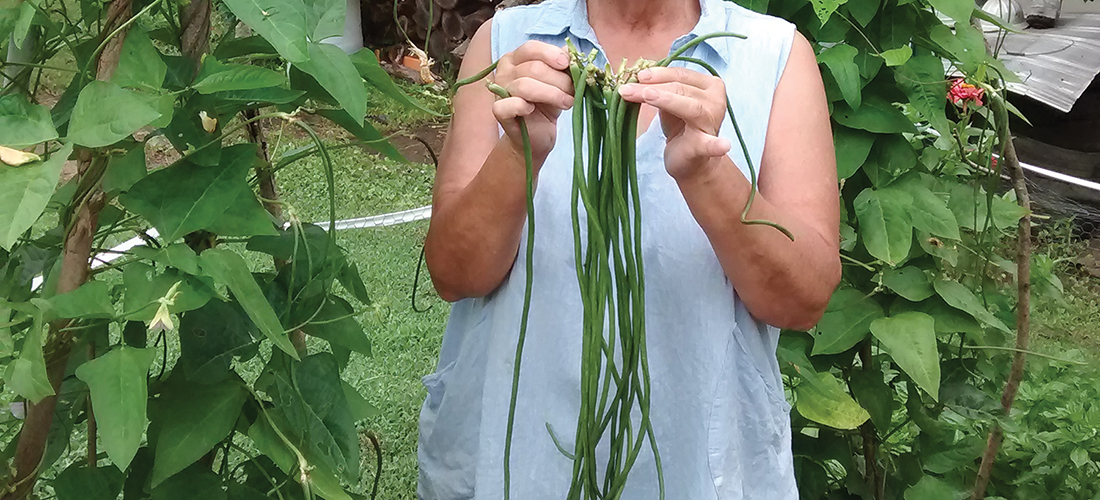
The Plot Thickens
In a community garden, everybody has an opinion
By David Claude Bailey
As Anne and I administered something akin to last rites to the garden plot we’d tended for 14 years, the sun punched through a drab January sky, looking like a candle burning a hole in a gray piece of paper. My wife and I were unearthing slumbering plants from our designated plot in Greensboro’s Mixed Greens community garden to take them to the abandoned dairy farm we’d rented near Whitsett. Our Egyptian walking onions would take a long trek to our new place, bedding down where cows once grazed. Out came clump after clump of hearty asparagus roots. We unearthed oregano and horseradish. We uprooted a thriving and luxurious artichoke plant, reminiscent, even in January, of a van Gogh painting.
As we packed the car, we agreed that what we’d miss most about community gardening was the community of gardeners, many of whom had become close friends. What we wouldn’t miss were several zealots who, from the time we got there, became a self-appointed group of antagonists. Our choice to garden organically, as we had done for decades, without commercial pesticides, herbicides or chemical fertilizer, clearly went against the grain with them. They all must have graduated from the same training program, I decided, one I imagined was akin similar to Marine Corps boot camp. They came off as know-it-alls who didn’t hesitate to tell us that there’s a right and wrong way of gardening — and ours was wrong.
“You can’t do that,” said one gentleman, who seemed to possess a wardrobe expressly for gardening — green canvas trousers, matching Crocs, a yellow t-shirt emblazoned with vegetable images. “That manure,” he warned, “will burn up anything you plant.” I was wearing garb similar to what my father had told me to put on when he first introduced me to “busting clods” at the age of 5: threadbare clothes too old to send to Goodwill. “We don’t expect much the first year,” I explained. “We’re really just building up the soil for the future.” We’d used load after load of compost and manure, the latter, donated by Ringling Bros. and Barnum & Bailey Circus after their annual visit, included fragrant lion and elephant scat. “That manure’s going to kill anything you plant,” he repeated.
Anne, who tends to be a little more diplomatic than I am, said, “We’ve been gardening organically more than 40 years, and we know what we’re doing.” After explaining once again how our plants would die a nitrogen-induced death of wilting agony, he marched off, shaking his head in disgust.
From then on, we continued to raise eyebrows — by using bamboo as a trellis for our snow peas, by planting Asian long beans that climbed into the sky like Jack’s beanstalk, by introducing a 150-gallon horse trough for Anne’s water lilies and goldfish, by turning down an offer to use the community’s bright red rototiller, by mulching our bed with newspapers — and recycled O.Henry magazines — to keep the weeds down, by putting a plastic snake among our strawberries to scare away birds, but most of all, by refusing to water during a summer that will be remembered for one of the severest droughts the Piedmont has ever witnessed. We were able to do this by converting our soil from a block of red clay into a loamy mélange of organic materials full of earthworms, and then by covering our plants with a thick blanket of mulch.
“Mulch is a medium for pests,” another outraged expert told us when a few bugs began nibbling the leaves of our beans. “You’re going to want to dust those plants.” When we responded that we were disinclined to do so, we got a lecture on containment. It was as if our garden were a Vietnam of pests and not nipping them in the bud would lead to takeovers in neighboring plots.
Whenever pests began eating our plants, we dusted them with diatomaceous earth or a mixture of snuff and cayenne pepper. If our beans continued to serve as a main course for the insect world, we simply pulled them up and planted something else.
But back to the drought of 2007–2008. Decades before, Anne had taught me to only water when absolutely necessary. She even introduced that weird practice to my father, who was raised on a tobacco farm, used chemicals liberally and watered daily all summer long. She explained that when you water continuously, the roots don’t grow deep into the ground and in consequence the plants become addicted to their daily dose of water. Too much water will also wash the nutrients away, she explained.
During the drought when neighboring gardeners offered to water our garden if we went out of town for a week, we said, thanks, but no thanks. And they were incredulous. They were more incredulous when, despite the drought, our lush, towering vines filled out with plump, ripe, red tomatoes — lots of them. Some of our neighbors even began asking for mulching advice — and for some of those old, discarded issues of O.Henry magazines.
On the main, though, we found almost all the gardeners friendly folks who generously shared their seedlings and crops with others. One year when early blight hit everyone’s tomatoes, Flossie told us about an organic product with micronutrients that had brought her tomatoes back from the brink, and then pulled her sprayer out and offered it to us right then and there. She was right, the tomatoes grew productive new branches and leaves. Our crop was saved. And Billie shared herbs and vegetables, as well as tips. Another gardener suggested we try Rotenone, a “natural, organic” pesticide. And “experts” were always available to generously help new gardeners with their plots.
We became the odd pair, and gradually the rigid experts left us alone. But they administered the garden, and one year when we were one month late sending in the check for the next year’s rent, our plot was given to someone else. No warning, no phone call, no notice. As soon as Anne realized we’d been negligent, she called about it and I remember the tears rolling down her face. Having spent hours and hours building tilth, nurturing earthworms and grooming out favorite perennials, losing our plot was like losing a pet. On the other hand, we had forgotten to pay the rent and rules are rules.
When the young gardener who rented our bed gave it up at the end of that summer, we got a call, asking if we didn’t want our old bed back — and that’s when we learned what community gardening was all about. That spring when we returned to reclaim our plot, we were greeted like long-lost friends by fellow gardeners.
Ginny, who was the one who invited us back, asked me if I was interested in volunteering. I let her know that my expertise was limited to heavy lifting, digging and operating a wheelbarrow, but soon I became the go-to guy for helping older members who were recovering from surgery or were too ill to tend to what they’d planted. As a result, I grew close to one of our early critics. We shared life stories one spring day when I helped him put in tomatoes, which I ended up caring for and picking and sending to him as he recuperated. Emily, who recruited my help with her runaway Jerusalem artichokes, turned out to be an avid birder, and she and Anne shared news of sightings of rare visitants like a rufous hummingbird that came to town.
Equally rare were some of the plants that gardeners from other countries grew — African corn that grew 15 feet high, rice that didn’t need to be planted in water and all sorts of peppers that were several times hotter than habaneros. The plot right next to ours belonged to Susan, who used to live in Africa. She generously shared some of her blisteringly hot peppers and childhood memories with us. Her entire bed was almost covered in some unusual greens, which one of the overenthusiastic fellow gardeners once pulled up, thinking they were weeds.
Spring is on the way, and out the window I can see arugula, kale, turnips, beets and mesclun thriving. Brussels sprouts have already been harvested and now snow peas are germinating in their place. The massive asparagus roots from our old community plot are doubtless wondering about their new surroundings, but I bet they’re liking the horse and cow manure all around them. Corn, pumpkins and watermelon, all discouraged in the community garden as too sprawling, are in our summer plans. Artichoke seedlings are thriving in the sunshine on our porch, while tomato and pepper seeds make plans in their flats. The other day, Anne put out lettuce, parsley, onion and cilantro sets under row cover, and sowed seeds of parsnips, beets and carrots. Before she planted, I worked in a few wheelbarrows of cow manure and mulch and followed up the planting with some wonderful composted hay I found nearby.
I told Anne that I almost missed the Greek chorus of Expert Gardeners wailing over our organic ways. They reminded me of the prophets of doom in my hometown of Reidsville who naysayed anything and everything that was the least bit ambitious or different. Over the years, I’ve come to realize, though, that some of the most generous and compassionate people on the planet live in that little town — along with some of the most cantankerous and mean-spirited. Just like any community, including a community garden. While it doesn’t take a village to raise a good, homegrown tomato, it does provide for a richer experience. OH
As contributing editor at O.Henry, David Claude Bailey contributes fresh tomatoes, cucumbers — and lots of zucchini — to the staff.





